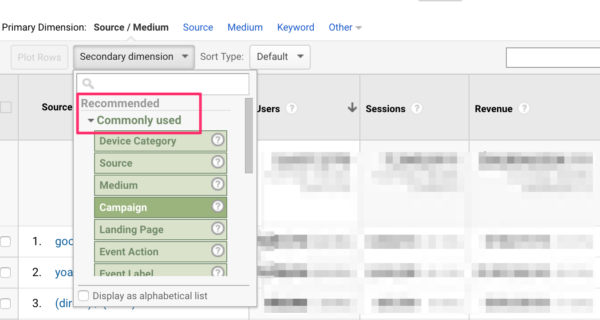Enhance Your Data Evaluation Using Additional Dimensions
In the world of data evaluation, key metrics commonly offer a fundamental understanding of performance or fads. The real depth of insights exists in the integration of second dimensions. These extra layers of information provide a nuanced sight that can untangle complexities and subtleties not obvious initially glimpse. The capacity to dissect details via various lenses opens up doors to a world of possibilities that can transform just how companies act and translate upon their information. The tactical use secondary dimensions raises evaluation beyond the surface level, guaranteeing a wide range of untapped potential waiting to be discovered.
Comprehending Second Measurements
Second measurements in information evaluation refer to additional characteristics or metrics that supply much deeper insights when combined with primary data dimensions, enhancing the overall understanding of the dataset. These additional dimensions provide a more extensive view of the data, allowing experts to discover concealed patterns, connections, and patterns that may not be evident when only taking into consideration primary dimensions.
By integrating additional dimensions right into data analysis, experts can obtain a more nuanced understanding of the elements influencing the primary metrics. For instance, in advertising analysis, key measurements might include basic consumer demographics like age and sex, while secondary dimensions can incorporate variables such as acquiring habits, preferences, or geographical place. By incorporating these main and secondary measurements, analysts can create extra thorough client accounts, allowing even more targeted and efficient marketing methods.
Additionally, second dimensions can aid in determining correlations in between various variables, causing even more accurate anticipating modeling and decision-making. They enable analysts to discover data from several perspectives, enhancing the insights attracted from the dataset and ultimately enhancing the top quality of analysis and calculated recommendations.
Benefits of Second Dimensions
When thinking about information analysis, incorporating secondary dimensions provides a wide variety of benefits that substantially boost the deepness and breadth of understandings acquired from main information dimensions. By adding secondary dimensions such as time, location, or group details to the evaluation, scientists can obtain an extra detailed understanding of the main information points.
Moreover, additional dimensions can likewise assist in segmenting data, allowing for a more thorough evaluation of certain subsets within the main data. This segmentation can bring about even more targeted methods and actions based on the distinct qualities of each segment. Additionally, second measurements can aid in validating searchings for from main data measurements, supplying a more durable and reputable basis for decision-making.
Essentially, the benefits of including additional dimensions right into data evaluation are indispensable, providing richer insights and enabling even more informed decision-making processes.
Implementing Second Dimensions Properly
Efficient implementation of second dimensions in information analysis requires a critical technique that maximizes the utility of added contextual info. When including secondary measurements, it is essential to straighten them with the primary dimensions to obtain deeper insights right into the data. Begin by plainly defining the goals of the analysis to figure out which secondary dimensions will certainly offer one of the most relevant context. It is necessary to choose secondary dimensions that match the key data without triggering noise or complication in the analysis.
Additionally, think about the scalability of the second measurements throughout various datasets or evaluations. Ensure that the chosen additional dimensions can be constantly used and analyzed across various scenarios to keep the honesty and uniformity of the evaluation. In addition, develop a systematic process for integrating additional dimensions into the analysis workflow to improve the interpretation of results. By executing secondary measurements properly, experts can boost the deepness and accuracy of their data evaluation, bring about even more educated decision-making and actionable insights.
Advanced Techniques With Secondary Measurements
For a more advanced approach to data evaluation, including secondary dimensions can substantially boost the depth of insights obtained. Advanced techniques with additional measurements involve more detailed methods to draw out beneficial information from data sets.
One more innovative technique is regression analysis, which assists determine partnerships between variables and exactly how they affect each various other. By including secondary dimensions, such as market details or customer actions, to regression models, you can uncover much more nuanced insights and make more precise forecasts.

Situation Studies: Second Dimensions at work

In one more scenario, a healthcare provider leveraged secondary dimensions to maximize resource allocation. By analyzing person results in regard to geographical area, the company recognized areas with high readmission prices. This caused the execution of targeted intervention programs in those areas, ultimately improving client care and reducing medical care costs.
These case researches show the power of second measurements in uncovering beneficial insights that drive calculated decision-making. By diving deeper into information evaluation past primary metrics, companies can acquire an extra thorough understanding of their operations and customers, bring about more informed and reliable service approaches.
Final Thought
In final thought, the incorporation of second dimensions in information analysis is crucial for obtaining a comprehensive understanding of underlying aspects and patterns. By utilizing methods such as mate evaluation and regression analysis, organizations can uncover hidden insights and make more enlightened decisions. Additional dimensions include depth and breadth to information analysis, enabling companies to check out information from multiple point of views and drive much more efficient outcomes.
In advertising evaluation, main official site measurements might consist of standard customer demographics like age and sex, while second dimensions might encompass variables such as buying actions, preferences, or geographic area.When taking into consideration information evaluation, incorporating second measurements uses a multitude of benefits that dramatically enhance the depth and breadth of understandings acquired from primary information measurements.In addition, additional measurements can likewise help in segmenting data, enabling for a more detailed evaluation of certain parts within the primary data. our website In addition, secondary dimensions can help in validating searchings for from main information measurements, providing an extra trustworthy and robust basis for decision-making.
When integrating additional dimensions, it is important to align them with the key dimensions to get much deeper insights into the information.